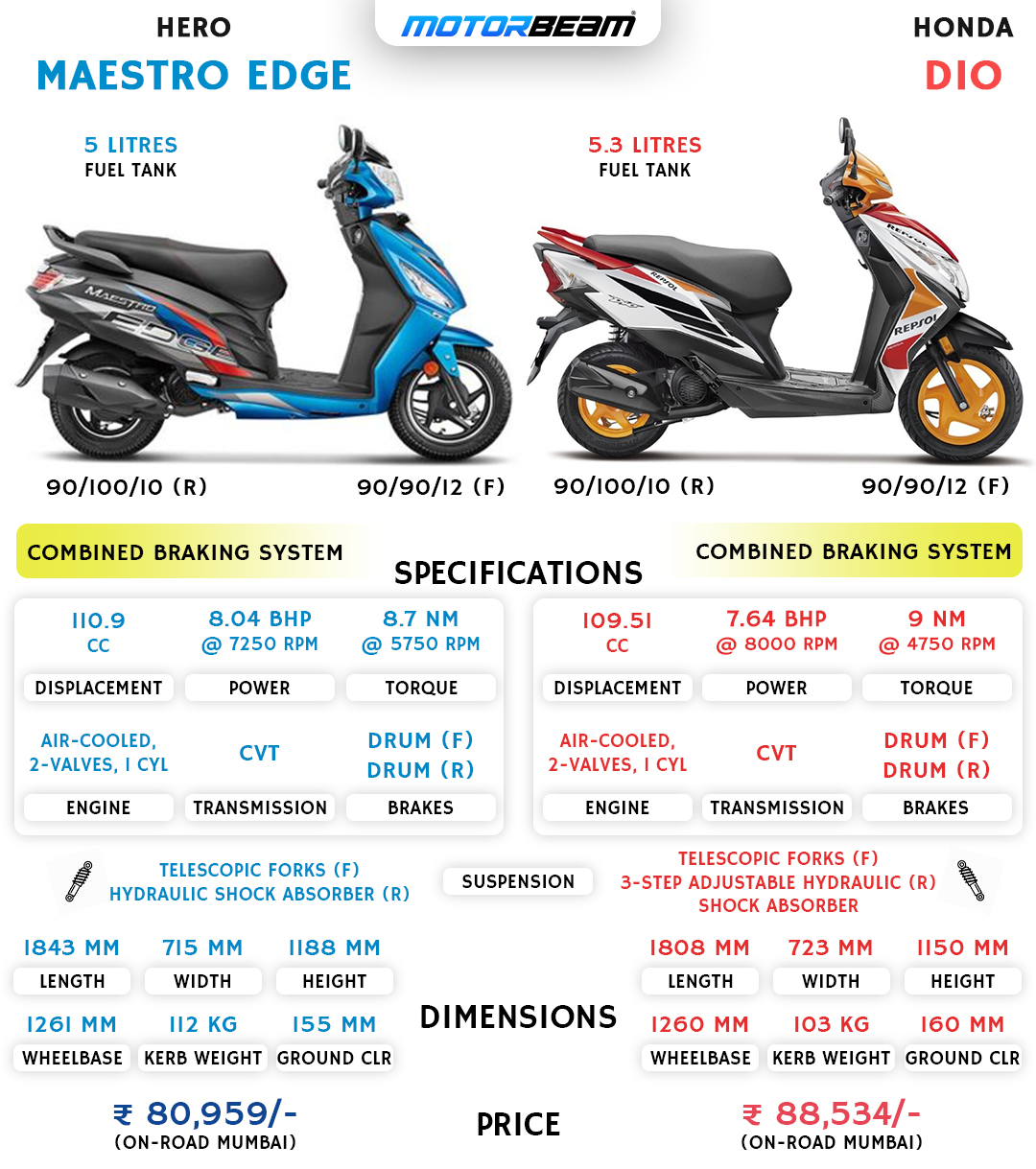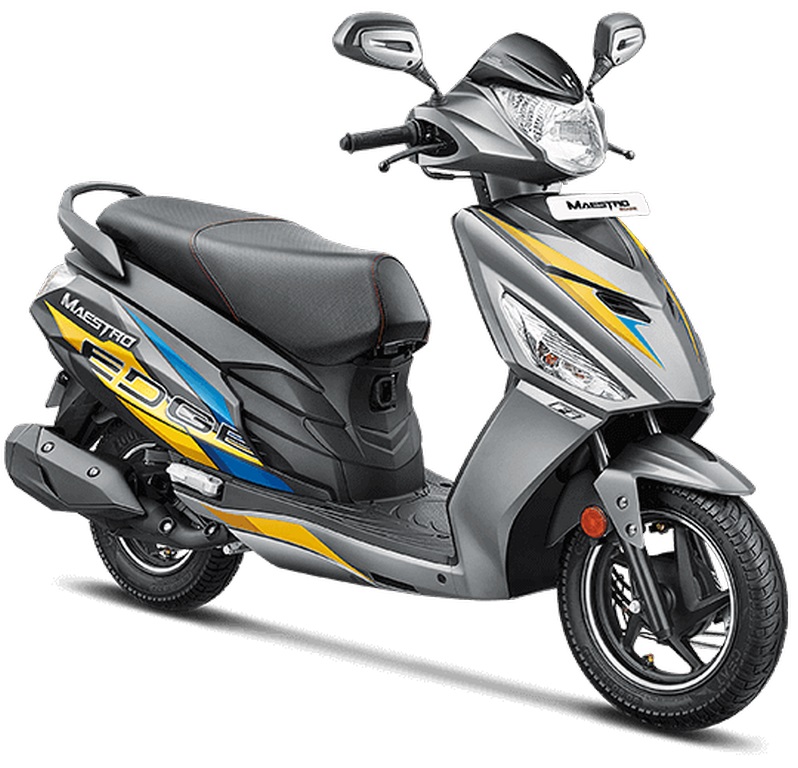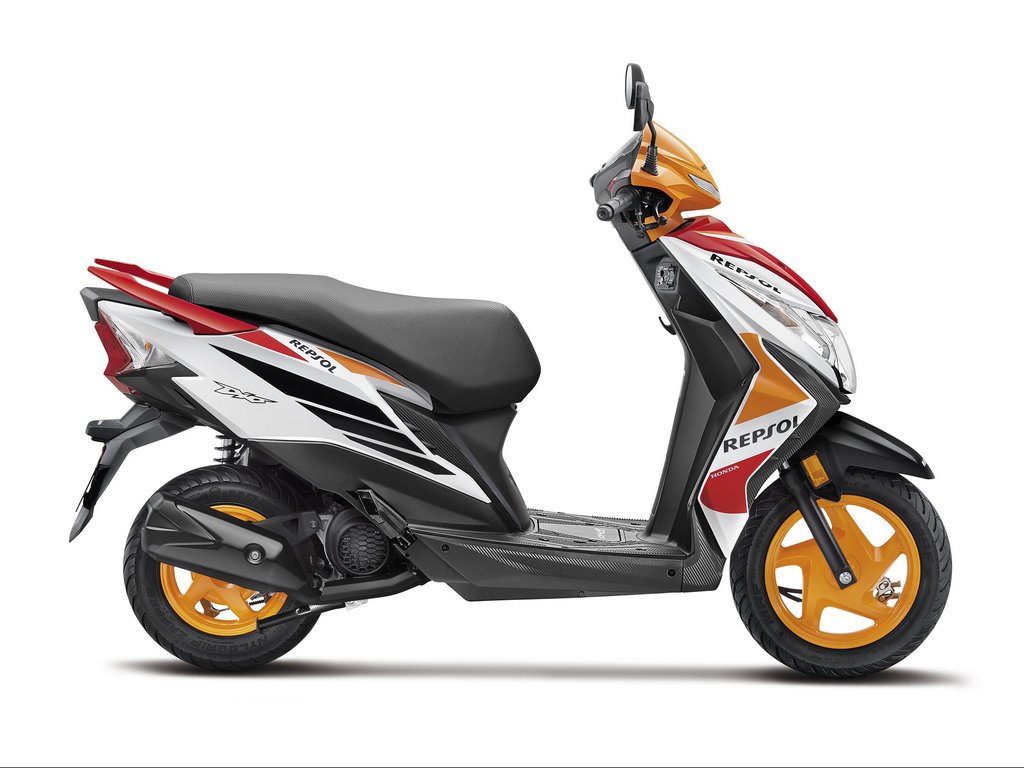Hero Maestro Edge 110 vs Honda Dio – Spec Comparison
Thorough spec comparison between the Hero Maestro Edge 110 and Honda Dio.
Thorough spec comparison between the Hero Maestro Edge 110 and Honda Dio.
Home » Bike News » Hero Maestro Edge » Hero Maestro Edge 110 vs Honda Dio – Spec Comparison

India is one of the largest two-wheeler markets in the world, and the scooter segment is an especially hot and competitive point here since it brings in a lot of sales. Scooters have transformed the commuting experience as they offer the best of both worlds, the economy and comfort of a bike paired with the ease and convenience of an automatic gearbox. With the scooter segment is flooded with options, we are here with a detailed spec comparison between the Hero Maestro Edge 110 and the Honda Dio to help you make a better choice.
The Hero Maestro has a very traditional and direct design. It gets an old-school handlebar-mounted halogen headlamp while the turn indicators are integrated into the front panel. The slim 5-spoke alloy wheels are finished in black to elevate the sporty vibe of the scooter. Apart from this, the Maestro features a lot of cuts and creases all over the body that gives it a fresh look. With the addition of two new colour options – Silver and Blue, the Maestro is available in a total of 7 colour options with updated, funky body decals. The rear profile of the scooter looks up to date, thanks to the wide LED taillamp. Overall, the Maestro has started to look and feel dated now and is due for a major design overhaul.
One of the main reasons behind the Dio’s success is the design. Here too, nothing much has changed, the body panels look similar to the previous iteration. And from a distance, it is a bit hard to guess the latest model. The Dio gets a small LED DRL up top and also gets an LED headlight unit. However, it misses out on a LED taillamp which is a slight bummer, considering its price. From the sides, the Dio looks a lot sleeker than the Maestro due to its smooth panels. The new Repsol edition gets orange alloy wheels which look quite blazing. While the lower variants get steel wheels. Honda offers a total of 8 colour options for the Dio. One of which is the Repsol edition.
Feature-wise, it is a tough battle between the two. Let’s discuss the common bits first. Both scooters get an external fuel filler, integrated seat and fuel lid opener placed in the ignition slot and combined braking system. The Maestro gets an analogue-digital instrument cluster. But the LCD cluster is very small and doesn’t offer good visibility under bright sunlight. Apart from the basics, the LCD cluster also presents a service reminder, twin trip meters and a side stand warning. The Maestro gets a mobile charging port and a nifty boot light. An interesting feature here is the ‘XSENS’ technology which intelligently adjusts vehicle performance depending on riding conditions.
On the contrary, the Dio offers a bigger and better, fully digital LCD instrument cluster which is pretty smart. It displays live mileage, average mileage, distance to empty, service indicator and a trip meter. It also gets an integrated kill switch and starter button which feels premium. Adding to the premium feel is the silent starter, which reduces the gear engagement noise, thus providing a silent start-stop. The Dio comes equipped with a side stand engine cut off sensor which makes sure that the side stand is always retracted before cranking the motor. Lastly, the Dio gets an open cubby hole at the dash, which can house easily house a 750 ml bottle.
Ergonomically, both the scooters have a neutral riding position, and offer a good amount of comfort for the rider and the pillion. Talking about the Maestro, the seat height at 775 mm is 10 mm taller than the Dio but, it isn’t challenging as such. The seat is wider and longer than the Dio however, the cushioning feels a tad too soft for our liking. The handlebar is short and has a decent weight to it. Though the mirrors are wide, they have limited adjustability. The footboard area has pretty decent dimensions and can comfortably accommodate your feet.
Now, talking about the Honda Dio. Firstly, the seat height is at 765 mm, which makes it a friendlier option for short riders. The seat cushioning feels slightly better on the Dio. It has a nice contour that acts like back support for the rider. The handlebar is slightly wider and well angled than the Maestro which gives you better leverage and the mirrors here have a tapered shape but offer good adjustability. And lastly, the footboard area is slightly wider than the Maestro giving you a little bit of extra space to move around.
The powerhouse to the Hero Maestro is a 110.9cc, air-cooled, 2-valve engine that produces 8.04 BHP at 7250 RPM and 8.7 Nm of torque at 5750 RPM. The acceleration from this motor feels a bit sluggish and slow compared to the Honda Dio due to the added 9 kg weight. The Hero is the better-sounding machine in between the two, having a more grunty exhaust. A contemporary fuel-injected fuel delivery system has taken the place of the previous carbureted fuel delivery system. This has resulted in better throttle response and better rideability. Lastly, the Maestro gets a 5-litre fuel tank which returns a fuel economy of 45 km/l, translating to a range of 200-230 km, depending upon your riding style.
The Dio here uses a 109.5cc, 2-valve engine that produces 7.64 BHP at 8000 RPM and 9 Nm of torque at 4750 RPM. Off the line, the Dio feels much peppier than the Maestro. The reason being, it produces 0.3 Nm more torque and delivers it 1000 RPM earlier at 4750 RPM versus 5750 RPM on the Maestro. The engine also feels a lot easier and less stressed, resulting in a much refined and meek sounding exhaust. To sum up, the 5.3-litre fuel tank returns a fuel economy of 48-50 km/l due to its less weight at 103 kg compared to 112 of the Maestro.
The Maestro is the better pick on the handling front. With a 10 mm higher seat height, it gives you a slightly better, commanding riding position. The telescopic forks up front and a hydraulic mono-shock back deliver noticeable road feedback. These springs, in combination with the 12-inch front and 10-inch rear wheels, provide excellent handling. However, the Maestro feels quite heavy to lean than the Dio, as it weighs a healthy 9 kg more than the Dio. Both the scooters have 130 mm drum brakes rather than disc brakes on the front and get backed by CBS which works pretty well.
Handling the Honda is a smooth affair. The riding posture is not that commanding as the Maestro but not at all less confidence-inspiring. Honda has provided it with similarly sized tyres like the Hero. The Honda inches forward with its 3-step adjustable rear suspension which feels plusher than the Maestro. And with less weight than the Maestro at 102 kg, it makes for a superb city machine for filtering through traffic and making tight turns. In the same manner, both the scooters come equipped with combined braking, providing satisfactory braking performance.
The Hero Maestro Edge 110, priced at Rs. 80,959/- which is almost Rs. 7500/- cheaper than the Honda Dio which offered at Rs. 88,534/- both on-road Mumbai. This pricing is for the top variants of both, while the price difference between the base variants is just Rs. 3000/-. The Honda Dio is the costlier option here. But if you are on a tight budget and want a no-nonsense scooter with good handling and sporty nature, Maestro should be your choice. On the other hand, the Honda Dio is a scooter that charges more premium for its reliability and added safety and lifestyle features.


